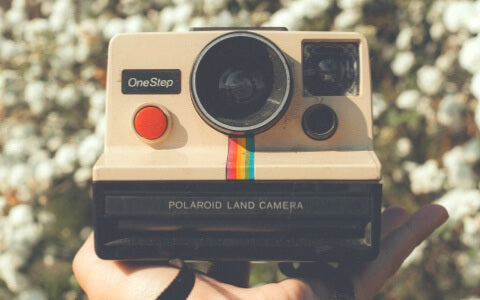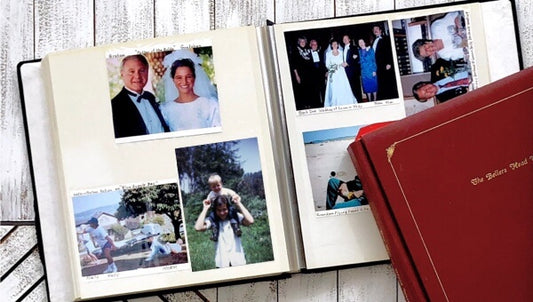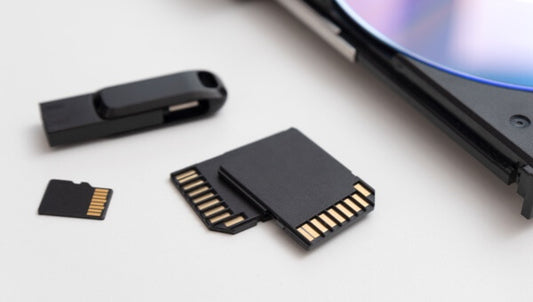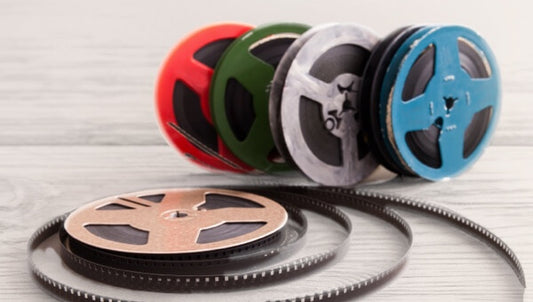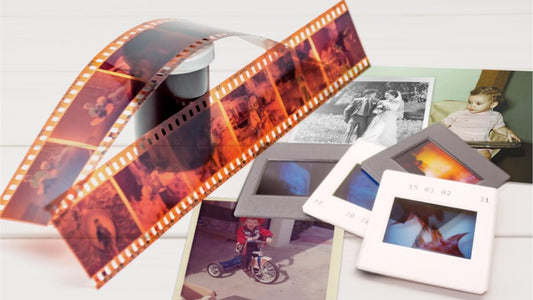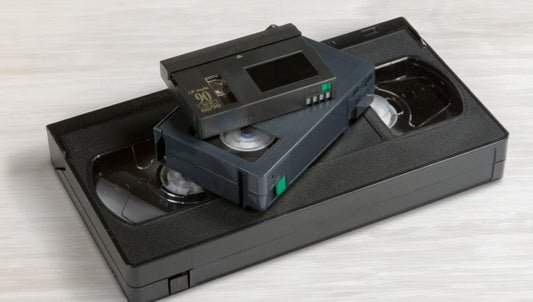Restoring your family photos can enhance the colors, eliminate scratches and cracks, preserve the original image, and protect your precious memories from further deterioration. You can restore photos yourself, but there are also restoration companies that can help you with professional restoration techniques.
While Capture doesn’t offer complete photo restoration, for over 20 years we’ve been preserving photo memories and offer complimentary glare removal, cropping, and color correction. However, if you want to restore other issues like significant fading or scratches, we put together this guide to 4 effective methods to help you out.
Keep reading to understand why picture restoration is necessary, the benefits of professional restoration, and how you can use digital restoration and other DIY methods to restore old photos on your own.
Why Old Photos Fade and Get Damaged Over Time
Photographs fade and deteriorate because of the materials they’re made from and the environments they’re stored in. Old photographs contain precious memories that you might want to view, share, and pass on to future generations. Unfortunately, family photos can experience damage over time, even if you take good care of them.
Old photos can fade over time which means instead of vivid colors, the images look dull, washed-out, or subdued. Additionally, the material can start to wear out and break down, especially when not stored properly.

Different methods for photo and picture restoration help bring memories back to life.
Even when organizing photos in photo albums with acid-free paper, environmental factors like sunlight, humidity, heat, and simply the passing of time can contribute to old damaged photos. They may also develop scratches, tears, creases, stains, or water damage that make it difficult to see important details.
By restoring damaged and faded photos, you eliminate all these damages, restore the color, and ensure that you can keep enjoying and sharing the images with loved ones.
1. Professional Restoration Services
The first option to restore photographs as well as photo slides and even negatives is to hire a professional restoration service. There are many benefits to choosing a professional company to restore photos.
Benefits of professional restoration:
- High-quality results – Professionals deliver excellent outcomes. Many offer special services like face enhancement, colorizing black-and-white photos, or complete picture restoration with digital JPG or PNG copies.
- Safe handling of originals – Your old photos are protected throughout the repair process. Many services provide satisfaction guarantees and take extra care to keep family memories secure.
- Digital delivery – Restored photos are often returned as high-resolution files, making it easy to save, print, and share with loved ones.
Drawbacks to consider:
- Higher costs – Professional photo restoration costs more than many of the options that you can use at home.
- Longer turnaround – It may take several weeks to get your old family photos back as well as the restored copies.
If you do choose photo restoration, make sure you compare the top options, their services, and their reputations. For example, if you want to primarily digitize your photos with some restoration involved, you need to compare ScanCafe vs Capture.
One of the best companies is FixThePhoto because their pricing is reasonable at $25-$50 per photo for fire and water restoration, mold repair, scratch removal, photo enhancer, and more to restore images. However, they don’t digitize old photos. Other popular options include WeEdit.Photos, Image Cleanup, and Smooth Photo Scanning.
2. Digital Restoration Techniques
DIY digital restoration is a popular way to restore old photos at home. With photo editing software such as Adobe Photoshop, Inpaint, PhotoScape, or Capture One, you can fix fading, scratches, and other damage. Some tools are advanced and take time to learn, while others have a simple interface that makes photo repair more user-friendly.
When choosing the best photo restoration software for your needs and goals, make sure you consider features like drag-and-drop photo editing, black and white photo colorization, scratch removal, and other photo enhancer tools that can help you perform restoration.
Additionally, you’ll need the best photo scanner for the type of photos you have that can digitize them into high-quality images. For example, a scanner for photo slides or Polaroids might not be great for 35mm negative scanning. You can also have Capture or another digitization service perform this step for you.
Here are the steps to scan and retrieve images, restore them, and save them:
- Scan images individually – Plug in your scanner, install the software, and scan one photo at a time, saving each file in an organized folder.
- Upload to editing software – Import the scans into your chosen photo editor. Drag-and-drop may be supported depending on the program.
- Crop the image – Remove damaged edges and save each version under a new file name so you can compare changes.
- Correct tone and color – Adjust brightness, contrast, and color sliders to bring clarity back to faded or discolored photos.
- Fix scratches and blemishes – Use dust and scratch tools to carefully repair damage, zooming in for precision and checking progress often.
- Fill tears or missing areas – Some software uses AI to clone or recreate parts of a photo that were torn or lost.
- Save, print, and share – Save the restored image, compare it with the original, and print or share digital copies with family and friends.
3. DIY Methods for Restoring Old Photographs
Another option to recover images and restore their original beauty is to physically clean and restore the photos. While this method won’t fix fading or scratches like digital tools, it can improve the photo’s condition before scanning and may help preserve delicate prints.
Steps to clean and repair photos at home:
- Clean surface debris – Use a soft-bristle toothbrush to gently brush away dirt, sand, or residue. For heavy buildup, carefully rinse the photo in room-temperature water and let it dry in a cool, dark place. If the image changes color (red, yellow, or white), stop and seek professional help.
- Repair small tears – Use acid-free tape to secure torn edges. Apply the smallest amount possible and only on the back of the photograph to avoid affecting the image itself.
- Flatten curled edges – Create a homemade humidification chamber with a plastic bin and a few inches of water. Place a wire rack above the waterline, set the photo on the rack, and close the lid. After a few hours, check for moisture and wipe any condensation. Remove the photo to dry, which should reduce or eliminate curls.
4. AI Photo Restoration Tools and Apps
The last method to recover photos is to use Android or IOS apps for photo retouching. You can use these types of phone apps to scan and restore photos. While they are unlikely to offer the high quality of professional restoration or in-depth specialized tools, they are typically fast, affordable, and somewhat effective for certain restoration needs.
Popular tools for restoring old photos include:
- YouCam Enhance (iOS) – An image enhancer that uses AI to revitalize old or low-quality photos. It automatically detects common defects, adjusts colors, and sharpens details with a single tap.
- PhotoMyne (iOS & Android) – Designed for scanning and photo stitching, PhotoMyne makes it easy to digitize albums. Its auto-enhance and colorization tools can remove blurriness or add realistic color to black-and-white images.
Preserving Restored Photographs
Once you restore the photos whether digitally or physically, it’s important to organize photos and store them properly. For physical photos, keep them in a dry, dark, cool place and if you keep them in albums make sure you use acid-free paper. Then, when you handle them try to pick them up from the edges.
For digitally restored photos, you should strive to make copies and save them on the cloud. If you don’t use the cloud, then we recommend storing them on at least two devices. That way deleted photos or damaged devices do not lose your favorite memories forever.
Capture offers digitization services for photos, negatives, and slides and we offer included cloud storage as well as automatic integration with your Google Photos library. We also offer the first-ever touchless photo album scanning, which means we can digitize photo albums without anyone having to touch the photos, making it perfect for digitizing old photos that might be damaged.
This prepares your entire photo collection for restoration in the highest possible quality because we also perform retouching and color correction during the digitization process. Then, you can use photo editing software and image enhancement tools to improve, edit, or combine photos or even create great presents for dad or mom while keeping the originals in premium condition.

Old photos fade, but your memories can last forever.
When to Seek Professional Help
When should you use professional photo restoration services? In many cases, DIY methods work well, but there are times when expert help is the safest choice. Consider hiring a professional if:
- Photos are severely damaged – Old prints that are brittle, discolored, water-damaged, or torn beyond repair require specialized equipment and techniques.
- Pictures are extremely old – Family photographs over 50–75 years old may need precise processes to recover without causing further harm, even if they don’t appear badly damaged.
- Photos are stuck in albums or frames – Professionals know how to safely remove and restore images from sticky albums or fragile frames.
- Slides and negatives need digitization – If you don’t have a professional scanner, a restoration service can digitize old slides or negatives while preserving the highest possible quality.
Professional photo restoration ensures that one-of-a-kind memories are preserved safely, giving you results that go beyond what home methods can achieve.
Bringing Old Pictures Back to Life
If you want to restore pictures that are discolored, faded, damaged, old, or blurry, then there are plenty of options. You can restore snapshots using phone apps or software, restore old photos using physical cleaning processes, or send them to a professional restoration service to retrieve pictures and restore them to their former glory.
For digital restoration, you’ll first need to convert photos to digital. Capture can transfer your photos, negatives, slides, and photo albums to digital in the highest possible quality to ensure a smooth restoration process.





